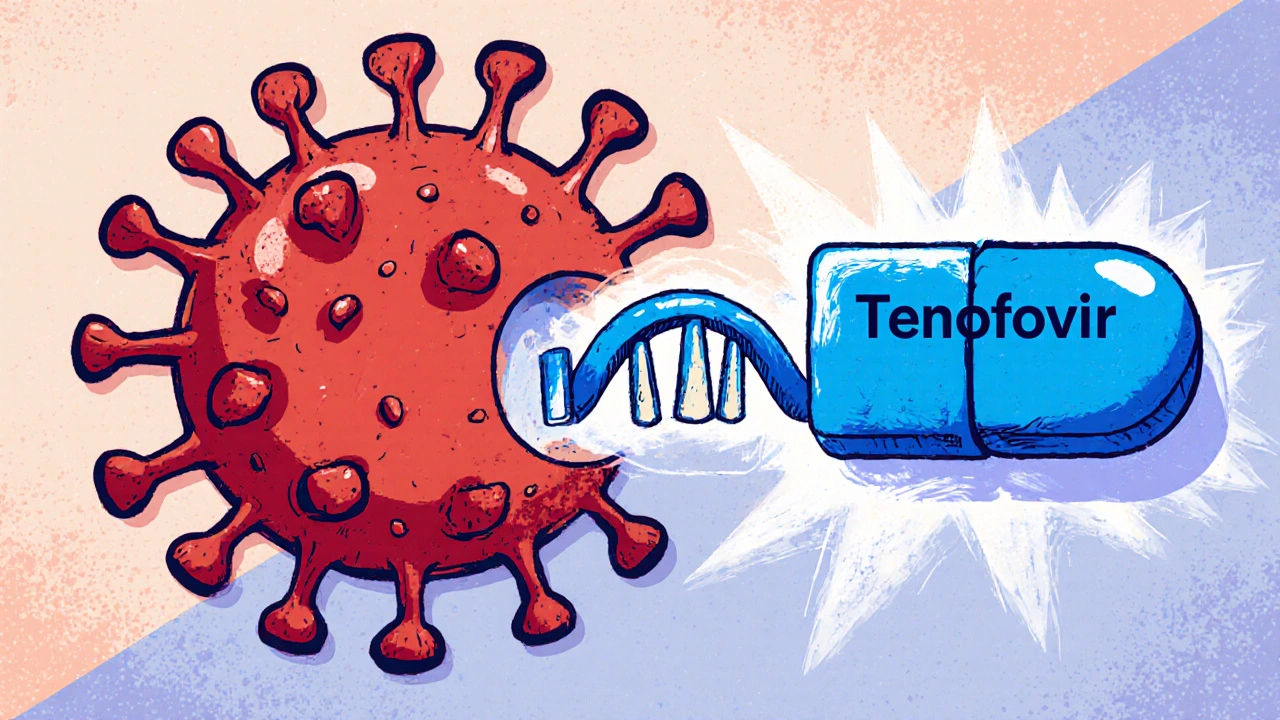Tenofovir Dosing & Safety Calculator
TDF vs TAF Comparison
300 mg daily
Original formulation
25 mg daily
Newer formulation
Key Advantage: TAF requires 1/10th the dose of TDF for equivalent antiviral effect
Dosing Calculator
Results
Calculating...
Safety information will appear here
Quick Summary
- Tenofovir is a nucleotide reverse‑transcriptase inhibitor used for HIV and hepatitisB.
- Two pro‑drugs dominate the market: Tenofovir disoproxil fumarate (TDF) and Tenofovir alafenamide (TAF).
- TDF requires a higher dose and can affect kidneys and bone; TAF uses a lower dose with fewer renal‑bone issues.
- Common side‑effects include nausea, headache, and occasional renal‑function changes.
- Adherence, drug‑interaction checks, and regular lab monitoring keep therapy safe and effective.
When discussing modern HIV and hepatitisB treatment, Tenofovir is a nucleotide reverse‑transcriptase inhibitor (NRTI) that blocks viral replication by mimicking natural nucleotides. It’s a cornerstone of antiretroviral therapy worldwide. If you’re new to Tenofovir, here’s what you need to know about how it works, the forms you’ll see on a prescription, and how to stay safe while taking it.
What Tenofovir Actually Does
Tenofovir targets the reverse‑transcriptase enzyme that HIV and hepatitisB viruses use to copy their genetic material. By inserting a faulty nucleotide, the drug halts the chain‑building process, preventing the virus from multiplying. This mechanism makes tenofovir a “viral replication stopper,” a description you’ll often see in pharmacy leaflets.
Two global health bodies, the World Health Organization (WHO) and the U.S. Food and Drug Administration (FDA), have approved tenofovir for both pre‑exposure prophylaxis (PrEP) against HIV and as part of combination therapy for chronic hepatitisB infection.
Pro‑drugs: TDF vs. TAF
Tenofovir itself is not taken orally; it’s administered as a pro‑drug that converts into the active molecule after absorption. The two most common versions are:
- Tenofovir disoproxil fumarate (TDF) - the original formulation, marketed under brand names like Viread® and generic equivalents.
- Tenofovir alafenamide (TAF) - a newer version that delivers the active drug more efficiently, allowing a 10‑fold lower dose.
Both achieve the same antiviral effect, but their safety profiles differ because of dosing and how much drug reaches the bloodstream.
| Attribute | TDF (Tenofovir disoproxil fumarate) | TAF (Tenofovir alafenamide) |
|---|---|---|
| Typical dose (adult) | 300mg once daily | 25mg once daily |
| Bioavailability | ≈25% | ≈92% (intracellular) |
| Renal safety | Potential decline in eGFR; monitor serum creatinine | Minimal impact on kidney function |
| Bone health | Reduced bone mineral density reported in long‑term users | Little to no effect on bone turnover markers |
| Approved for | HIV treatment, PrEP, HepatitisB | HIV treatment, HepatitisB (since 2016) |
How to Take Tenofovir Correctly
- Take the tablet with a full glass of water. Food does not significantly affect absorption, so you can take it with or without meals.
- If you’re on TDF, drink plenty of fluids (at least 2L per day) to help the kidneys flush the drug.
- Never split or crush extended‑release tablets unless your pharmacist advises you to do so.
- Stick to the same time each day; consistency improves viral suppression rates.
For patients with chronic kidney disease (eGFR<60mL/min/1.73m²), clinicians often switch from TDF to TAF to lower renal exposure. Always discuss dose adjustments with your prescriber before making changes.
Common Benefits and Efficacy
Clinical trials consistently show that tenofovir‑based regimens achieve viral suppression rates above 90% within 24weeks for treatment‑naïve HIV patients. For hepatitisB, tenofovir maintains undetectable HBV DNA in roughly 95% of patients after one year of therapy.
Because the drug has a high barrier to resistance, it remains a core component of first‑line combination pills like Truvada® (emtricitabine+TDF) and Descovy® (emtricitabine+TAF).
Safety Profile: What to Watch For
While tenofovir is generally well‑tolerated, certain adverse events deserve attention.
- Renal effects: TDF can cause a modest rise in serum creatinine and a reduction in estimated glomerular filtration rate (eGFR). Baseline labs and quarterly checks are standard practice.
- Bone mineral density: Long‑term TDF use may lead to loss of bone mineral density, especially in younger adults. DEXA scans are recommended for patients with risk factors.
- Gastrointestinal symptoms: Nausea, diarrhea, and abdominal discomfort are reported in up to 10% of users.
- Lactic acidosis: Rare but serious; watch for unexplained fatigue, rapid breathing, or abdominal pain.
Switching to TAF mitigates most renal and bone concerns because the lower systemic exposure means less drug reaches the kidneys and bone tissue.
Drug Interactions You Need to Know
Tenofovir’s elimination pathway involves the kidneys, so drugs that affect renal tubular secretion can change its levels.
- Non‑steroidal anti‑inflammatory drugs (NSAIDs): May increase nephrotoxic risk when combined with TDF.
- Proton‑pump inhibitors (PPIs): Can reduce absorption of TDF if taken simultaneously; separate dosing by at least 2hours.
- Antacids containing aluminum or magnesium: May bind tenofovir and lower its bioavailability; again, separate by a couple of hours.
- Other antivirals (e.g., didanosine): Rarely used today but historically increased mitochondrial toxicity.
Always hand your pharmacist a complete medication list, including over‑the‑counter supplements, to avoid hidden interactions.
Adherence Tips: Making Tenofovir Work for You
Missing doses can fuel viral rebound and resistance. Here’s a short checklist that helps patients stay on track:
- Set a daily alarm on your phone or smartwatch.
- Keep a pill box that’s refilled each month.
- Link the dose to a daily habit (e.g., brushing teeth).
- Schedule regular pharmacy refills; many services offer automatic deliveries.
- Ask your clinician about long‑acting options (e.g., cabotegravir) if daily pills become a burden.
For people on PrEP, the “four‑times‑a‑week” rule works as long as each dose is at least 48hours apart. Still, daily dosing remains the gold standard for consistent protection.

Special Populations
Pregnancy: Tenofovir is classified as Pregnancy Category B (FDA) and is recommended by WHO for pregnant women living with HIV because it reduces mother‑to‑child transmission.
Children: Dosing is weight‑based. For TDF, the recommended dose is 8mg/kg (max 300mg) once daily. TAF is still under study for pediatric use, so clinicians generally stick with TDF in younger patients.
Elderly patients: Reduced renal function is more common, so TAF is often preferred. Baseline eGFR measurement is mandatory before initiation.
Monitoring and Follow‑Up
Routine lab work is the backbone of safe tenofovir therapy. A typical schedule looks like this:
- Baseline: HIV viral load, CD4 count, HBV DNA (if applicable), serum creatinine, eGFR, phosphorus, and bone mineral density (if risk factors exist).
- Week 4: Creatinine and phosphorus to catch early renal changes.
- Every 3-6months: HIV viral load, CD4, renal panel, and bone health assessment when on TDF.
- Annually: Full metabolic panel and DEXA for high‑risk patients.
Adjust the regimen if eGFR drops below 30mL/min/1.73m²; switch to TAF or consider an alternative NRTI like abacavir (if HLA‑B*57:01 negative).
Frequently Asked Questions
Can I take Tenofovir if I have mild kidney problems?
Yes, but the dose may need adjustment. For eGFR 50-60mL/min, many clinicians switch from TDF to TAF because the lower systemic exposure reduces renal stress. Always get a doctor’s order before changing.
Is Tenofovir safe during pregnancy?
Yes. WHO and CDC both recommend tenofovir‑containing regimens for pregnant people living with HIV to lower transmission risk. Report any side‑effects to your obstetrician.
What’s the difference between Viread and Truvada?
Viread is tenofovir disoproxil fumarate as a single‑pill monotherapy, mainly used for hepatitisB or as part of a multi‑drug regimen. Truvada combines tenofovir (TDF) with emtricitabine; it’s a common HIV‑treatment and PrEP option.
Do I need to take any supplements with Tenofovir?
Calcium and vitaminD can help protect bone health, especially on TDF. However, avoid calcium supplements taken within two hours of the dose because they can bind tenofovir and lower absorption.
How quickly does Tenofovir lower HIV viral load?
Most patients see a 1-2log drop in viral load within the first 4weeks. Full suppression (undetectable) usually occurs by week12-24 if adherence is good.
Bottom Line
Tenofovir remains a workhorse in the fight against HIV and hepatitisB. Understanding the distinctions between TDF and TAF, monitoring kidney and bone health, and staying consistent with dosing will help you or your loved one get the most out of the medication. Keep the conversation open with your healthcare team, and don’t hesitate to ask for labs or a switch if side‑effects creep up.

Steve Holmes
October 17, 2025 AT 13:15Wow, this guide is super helpful, especially for newbies like me, and I love how you broke down TDF vs. TAF, it's crystal clear!!! The way you highlighted the renal and bone safety differences, and the dosing info, really saves a ton of confusion, thanks a lot!!! Also, the quick summary at the top is perfect for a fast skim, and the detailed tables later are gold! Keep up the awesome work, can't wait for more updates!!!
Tom Green
October 26, 2025 AT 18:29Thanks for putting together such a thorough overview. The balance between informal explanations and the technical table makes it accessible for both patients and clinicians. I especially appreciate the clear instructions on hydration and timing, which are often overlooked. This kind of practical guidance really helps improve adherence and safety in everyday practice.
Emily Rankin
November 5, 2025 AT 00:42Reading this piece felt like stepping into a grand theater of virology, where Tenofovir takes center stage as the heroic savior against the relentless tide of HIV and hepatitis B. Each paragraph unfolds like a carefully scripted act, introducing the protagonist-a nucleotide analogue that masquerades as a building block, only to halt the viral polymerase with ruthless efficiency. The contrast between TDF and TAF is painted with the vibrant colors of a modern masterpiece, one heavy‑handed and robust, the other sleek, elegant, and whisper‑quiet. You can almost hear the sigh of relief from patients whose kidneys no longer bear the brunt of a high‑dose regimen. The tables, crisp and orderly, serve as a map guiding clinicians through the labyrinth of dosing, bioavailability, and safety. In the section on proper administration, the advice to stay consistent feels like a gentle reminder from a seasoned mentor, urging us to keep the rhythm of treatment unbroken. The mention of hydration, a simple yet profound gesture, underscores the humility required in managing complex therapies. Even the subtle nod to regular lab monitoring becomes a lyrical chant, echoing the importance of vigilance. I love how the guide interweaves scientific rigor with patient‑centric language, making the science feel alive and approachable. The brevity of the bullet points at the beginning acts like an overture, setting the tone for what follows. As I read about the potential side‑effects, the words are tempered with empathy, assuring readers that nausea and headaches are manageable companions on the road to viral suppression. The cautionary notes on renal function feel like a guardian watch, protecting us from complacency. Overall, this guide transforms dry pharmacology into a narrative journey, inviting both the curious layperson and the seasoned provider to travel together. It reminds us that behind every pill lies a story of hope, resilience, and scientific triumph. Thank you for crafting such a masterful composition that resonates long after the final sentence.
Rebecca Mitchell
November 14, 2025 AT 06:55Great summary
Lauren Sproule
November 23, 2025 AT 13:09im really glad this guide covers the basics of tenofovir its super helpful for folks who are just startin out with their meds and want to stay safe
CHIRAG AGARWAL
December 2, 2025 AT 19:22Honestly, this stuff is overhyped, who needs a whole guide for a pill that’s been around forever??
genevieve gaudet
December 12, 2025 AT 01:35Tenofovir’s journey from lab bench to global health hero feels like a modern day odyssey, bridging cultures and saving lives across continents, it’s amazing how a single molecule can unite us all in the fight against disease
Patricia Echegaray
December 21, 2025 AT 07:49Don’t be fooled by the glossy narrative, the real players behind tenofovir’s rollout are big pharma and shadowy agencies pushing agendas that don’t always align with the common folk’s best interests, stay woke